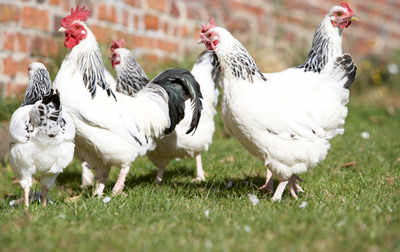Until recently, chicken producers would routinely supplement poultry feed with a growth-promoting arsenical drug called roxarsone, which also treats intestinal parasites in the birds and gives their meat an appealing pink color. A study in this issue of EHP shows that inorganic arsenic (iAs) accumulates in the breast meat of broiler chickens, potentially as a result of treatment with roxarsone.1
In 2011 the U.S. Food and Drug Administration (FDA) found that the livers of roxarsone-treated chickens had elevated levels of iAs,2 a known human carcinogen.3 In response, roxarsone’s manufacturer, Pfizer, voluntarily pulled the drug off the U.S. market, although it is still sold overseas, and a similar arsenical drug is still available in the United States.4 Sampling for the new study took place between December 2010 and June 2011, before Pfizer withdrew roxarsone from the U.S. market.
Roxarsone is an organic form of arsenic, which although less toxic to humans than the inorganic species implicated in cancer, has been shown to affect the growth of endothelial cells in culture.5 When roxarsone was approved by the FDA it was believed the drug passed through chickens unchanged. The FDA and new EHP studies each suggest that roxarsone can transform into iAs and accumulate in the edible portions of the birds, making the toxic metal available for human consumption.
For the current study, lead author Keeve Nachman, director of the Farming for the Future program at the Johns Hopkins Center for a Livable Future, and colleagues analyzed chicken breast meat samples from three categories: 1) conventional chickens for which arsenical drug use was permitted (69 samples); 2) conventional antibiotic-free chickens for which arsenical drug use was unlikely but possible since arsenical drugs are not considered antibiotics (34 samples); and 3) chickens certified as organic by the U.S. Department of Agriculture, which are not fed roxarsone and other arsenical feed additives (37 samples). The samples came from 82 stores in 10 U.S. metropolitan areas. Some of the samples underwent arsenic speciation, and for a subset of these the authors compared paired cooked and raw samples.
The results showed that iAs was highest in cooked conventional chicken meat (with a geometric mean of 1.8 µg/kg) and lowest in cooked organic chicken meat (with a geometric mean of 0.6 µg/kg). According to Nachman, arsenic found in organic chicken meat reflects exposure from other potential sources, such as drinking water. In addition, chicken meat with detectable roxarsone had higher iAs concentrations than chicken meat without detectable roxarsone.1
The study authors also performed a risk analysis based on iAs concentrations measured in their samples, estimates of the amount of chicken consumed over a 70-year lifetime, and the relationship between iAs consumption and the risk of cancer. Based on these assessments, they estimated that if all chicken producers were to use arsenic-based drugs, the added iAs exposure from consuming chicken would result in an additional 3.7 bladder and/or lung cancers per 100,000 people, or an average of 124 cancers in the United States per year.1 “Our study gives the FDA a clear rationale for withdrawing its approval for roxarsone and potentially other arsenic-based drugs in animal agriculture,” Nachman says.
References
1. Nachman KE, et al. Roxarsone, inorganic arsenic, and other arsenic species in chicken: a U.S.-based market basket sample. Environ Health Perspect 121(7):818–824 (2013); http://dx.doi.org/10.1289/ehp.1206245.
2. Kawalek JC, et al. Final Report on Study 275.30: Provide Data on Various Arsenic Species Present in Broilers Treated with Roxarsone: Comparison with Untreated Birds. Laurel, Rockville, and College Park, MD:U.S. Food and Drug Administration (11 September 2009). Available: http://goo.gl/4SGw9
3. International Agency for Research on Cancer Working Group on the Evaluation of Carcinogenic Risks to Humans. Arsenic, Metals, Fibres, and Dusts. Volume 100 C: A Review of Human Carcinogens. Lyon, France:International Agency for Research on Cancer (2012). Available: http://goo.gl/CLWjk [accessed 22 May 2013].
4. Tavernise S. Study finds an increase in arsenic levels in chicken. The New York Times, Health section, online edition (11 May 2013). Available: http://goo.gl/U5fYp [accessed 22 May 2013].
5. Basu P, et al. Angiogenic potential of 3-nitro-4-hydroxy benzene arsonic acid (roxarsone). Environ Health Perspect 116(4):520-523 (2008); http://www.ncbi.nlm.nih.gov/pmc/articles/PMC2290980/.
Arsenical Association: Inorganic arsenic may accumulate in the meat of treated chickens
Charles W. Schmidt, Environmental Health Perpectives






Leave A Comment
You must be logged in to post a comment.